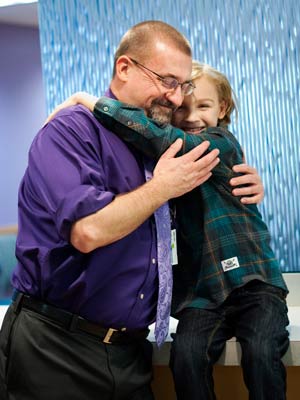 Tori Bates started running as soon as she saw the dead branch high in the tree start plummeting toward the ground. “It was headed straight for Logan like an arrow,” she says.
Tori Bates started running as soon as she saw the dead branch high in the tree start plummeting toward the ground. “It was headed straight for Logan like an arrow,” she says.
The 10-pound branch hit 5-year-old Logan, who was on a rope swing, on the left side of his head. Tori rushed to scoop him up, expecting a gush of blood, but she found nothing more than a small bump. Logan had no visible bleeding. He was awake and talking. “He seemed fine,” Tori
says. “But my gut told me we needed to get to the hospital.”
Before reaching the emergency room closest to their Poquoson home, Tori glanced back to see Logan unconscious in the backseat. She reached behind her, shaking his leg to wake him up. Logan’s eyes opened as they arrived at the hospital and, for a time, he seemed himself again. But soon
after, he began to vomit and his speech became slurred and garbled.
After a CT scan, the emergency room doctor delivered surprising news. “I expected to hear that Logan had a concussion,” says Tori. “But instead, he said they’d called for the CHKD transport team.” The tree branch had fractured Logan’s skull, resulting in a bleed on his brain.
Head injuries are the most prevalent critical injuries in children. Like other pediatric traumas, head injuries can happen anywhere, to any child, and immediate expert care is often vital to a successful recovery. At CHKD, Logan would have access to the region’s only pediatric
neurosurgeons, specially-trained to handle injuries to the brain and spine in children.
Tori followed the transport to CHKD, stunned at the seriousness of Logan’s injury. “I pulled up to CHKD just as they were unloading Logan from the transport truck. He looked so tiny on the stretcher, with strangers all around. But they were joking with him and making him laugh. He
told me they watched videos on the ride,” Tori says. “They knew just how to make him feel calm and safe, and I was so grateful.”
At CHKD, pediatric neurosurgeon
Dr. Gary Tye diagnosed Logan with a dangerous form of head injury called an epidural hematoma. The fracture to his skull had torn blood vessels in his head, causing bleeding between the skull and the dura, a thick membrane covering the brain. Patients
can appear normal for a period of time after suffering an injury like this before rapidly deteriorating as clotting blood compresses the brain. Without immediate and proper care, Logan could suffer permanent brain damage or even die.
Dr. Tye explained to Tori that surgery was needed to relieve the pressure on Logan’s brain. “He was calm, but made it clear that this surgery must be done immediately,” says Tori. “We talked in the hallway as they wheeled Logan to the operating room. They didn’t waste a moment.”
“Timing is everything with an injury like this one,” says Dr. Tye. “We had to quickly perform a craniotomy, removing a portion of Logan’s skull to gain access to the area of bleeding. Once the bleeding was controlled and the blood clot removed, his skull would be reattached using
small titanium plates to hold the bones in place as they healed.”
It was approaching midnight when Logan’s surgery began. Tori was alone in the deserted surgical waiting room when CHKD chaplain Ernestine “Tina” Lewis, who had just ended her shift, joined her. “She was off duty for the night, but waited with me anyway, “says Tori. “I’ll never forget her sitting with me in the dark, holding
my hands as we waited for the phone to ring with updates from the surgery. It meant the world to me.”
After reassuring news from Dr. Tye that the surgery had gone well, Tori slept fitfully in a chair at Logan’s bedside in the pediatric intensive care unit and waited for her son’s eyes to open. When he awoke, she knew immediately he was going to be okay. “He was quite angry to find he was no
longer wearing his own clothes, but it was wonderful to see,” says Tori. “I knew it was a good sign.”
 Logan was discharged after just four days in the hospital, but would spend more than a month recovering at home before returning to his kindergarten class. As his brain healed, he suffered mood swings and struggled to remember names and faces of some of his closest friends. He had to
re-learn the reading and writing skills he’d learned in school and simple tasks like how to shut a door. “Once he tried to save an ice cream sandwich, not remembering it would melt,” says Tori. “Those weeks were difficult for him and very challenging for me and his older brother.”
Logan was discharged after just four days in the hospital, but would spend more than a month recovering at home before returning to his kindergarten class. As his brain healed, he suffered mood swings and struggled to remember names and faces of some of his closest friends. He had to
re-learn the reading and writing skills he’d learned in school and simple tasks like how to shut a door. “Once he tried to save an ice cream sandwich, not remembering it would melt,” says Tori. “Those weeks were difficult for him and very challenging for me and his older brother.”
Because of his timely treatment, the damage to Logan’s brain was temporary. Just five weeks after the accident, he had healed enough to return to school – under strict orders from Dr. Tye that playtime consist of both feet on the floor at all times. Logan would require extra help in reading
throughout that year, but was able to move up to first grade with the rest of his class.
“Logan was a lucky boy,” says Dr. Tye. “Minutes matter in an injury like this. His mother’s instinct to take him to the emergency room helped to ensure the positive outcome he had.” Dr. Tye advises parents that any child who has suffered a fall or a blow to the head and is experiencing
symptoms such as vomiting, loss of consciousness, confusion or unusual speech should seek medical attention right away. And if the injury is dramatic, like Logan’s, medical evaluation should be pursued even if symptoms are not immediately apparent.
Despite Logan’s excellent outcome, Tori still gets emotional when she recalls the details of his story. “There is not a time that we come to see Dr. Tye that I don’t cry happy tears,” Tori says. “This is the person that saved my son’s life. Everyone at CHKD made
me feel that I could completely trust my child in their hands. From now on, every time I see someone in scrubs, I’ll know that I may well be looking at someone’s hero – like the people at CHKD are mine.”